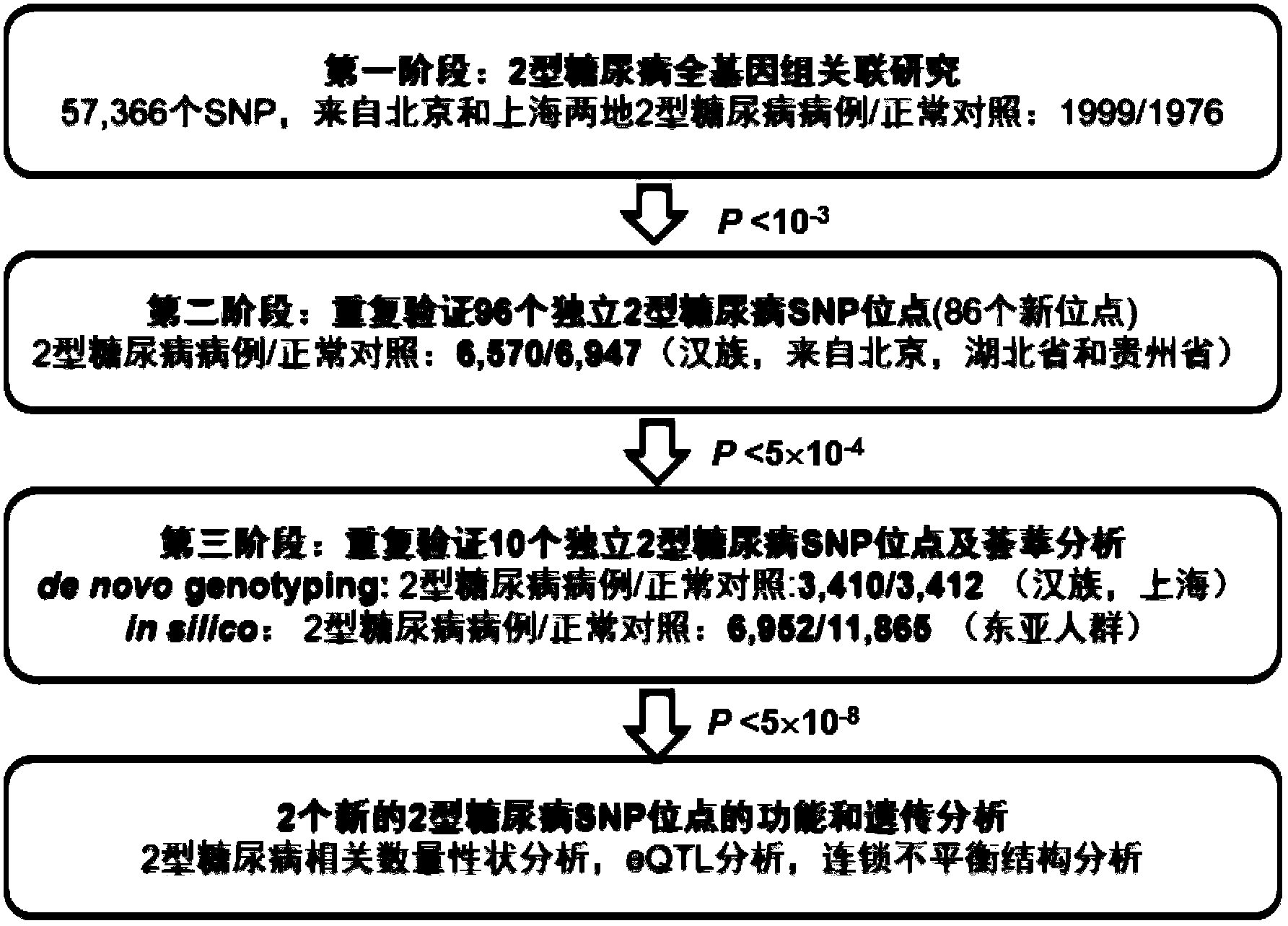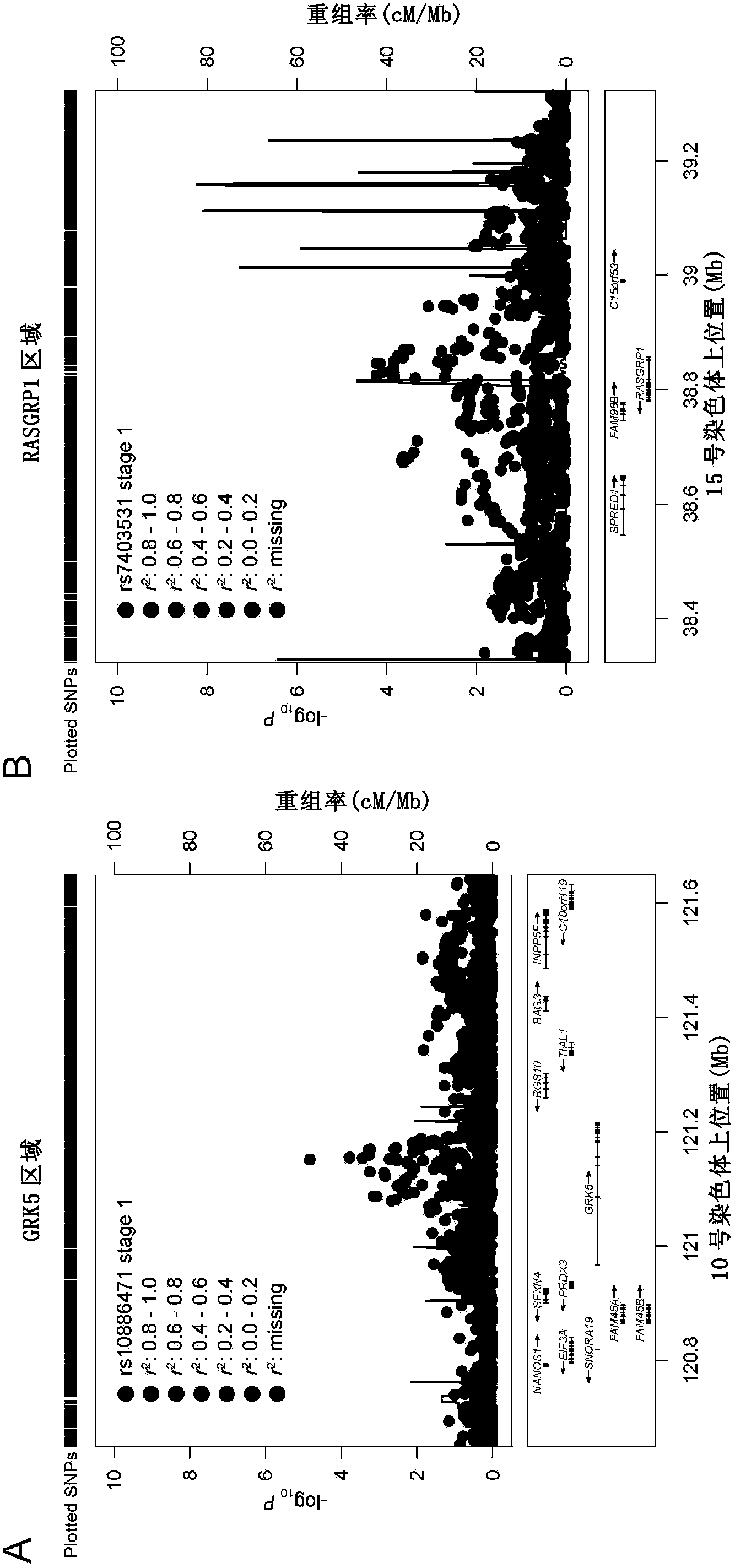Type 2 diabetes susceptibility genetic locus as well as detection method and kit thereof
A type 2 diabetes, kit technology, applied in the fields of molecular biology and medicine, can solve the reports that do not confirm the correlation between GRK5 gene or RASGRP1 gene and type 2 diabetes, the risk allele effect value is small, and there is no confirmation that SNP is related to type 2 diabetes. Type 2 diabetes related reports and other issues
- Summary
- Abstract
- Description
- Claims
- Application Information
AI Technical Summary
Problems solved by technology
Method used
Image
Examples
Embodiment 1
[0105] Identification of SNPs associated with type 2 diabetes
[0106] 1.1 Study population
[0107] The inventors carried out a genome-wide association analysis study (GWAS) of type 2 diabetes in several independent population samples, and the study included 3 research periods. A total of 1,999 diabetic patients and 1,976 non-diabetic controls were included in the population samples used for the first phase of genome-wide microarray analysis. The sample comes from the following population surveys: "Nutrition and Health Status Survey of Middle-aged and Elderly People in China (NHAPC)" (312 cases and 815 controls), "Gut Microbiota and Obesity Study (GMOS)" (82 cases and 163 Control), "Fudan Huashan Study (FDHS)" (807 cases and 339 controls), and "Beijing Diabetes Survey (BDS)" (798 cases and 659 controls). A total of 13,517 unrelated Chinese Hans (6,570 diabetic patients and 6,947 non-diabetic controls) were included in the sample used to validate the 96 T2DM loci in the seco...
Embodiment 2
[0143] Type 2 Diabetes Susceptibility Detection Kit
[0144] As described in Example 1, the presence of rs10886471 of the GRK5 gene: that is, the 134th C→T mutation in SEQ ID NO.: 1 is closely related to type 2 diabetes. Therefore, based on this mutation, GRK5 gene-specific primers can be designed to amplify and detect using the patient's DNA as a template.
[0145] Prepare a test kit (100 person-times), which contains:
[0146]
[0147] A test group composed of 100 people was randomly selected, including subjects who were unknown whether they had type 2 diabetes, patients who were known to have type 2 diabetes, and normal people who had been tested without type 2 diabetes.
[0148] Draw 3ml of peripheral blood from the subject to be tested in the test group, and use conventional methods (or use a specific kit) to extract DNA from the blood. Dilute the PCR primers in the type 2 diabetes detection kit to 1μmol / μl, and use the extracted DNA as a template to perform PCR reac...
Embodiment 3
[0154] Auxiliary testing for susceptibility to type 2 diabetes
[0155] Repeat the detection of Example 2, the difference is that 80 people are randomly selected (whether they have symptoms of type 2 diabetes before the detection) for detection.
[0156] Prepare a test kit (100 person-times), which contains:
[0157]
[0158] Draw 3ml of peripheral blood from the subject to be tested, and use conventional methods (or use a specific kit) to extract DNA from the blood. Dilute the PCR primers in the type 2 diabetes detection kit to 1μmol / μl, and use the extracted DNA as a template to perform PCR reaction with the provided primers. After the PCR product was purified, it was sequenced with an ABI 3730 DNA sequencer, and the sequence was read and SNP confirmed with Polyphred software.
[0159] The results also confirmed that the proportion of type 2 diabetes in the test subjects containing the 134th C site in rs10886471SEQ ID NO.:1 was significantly higher than that of the test...
PUM
 Login to View More
Login to View More Abstract
Description
Claims
Application Information
 Login to View More
Login to View More - R&D
- Intellectual Property
- Life Sciences
- Materials
- Tech Scout
- Unparalleled Data Quality
- Higher Quality Content
- 60% Fewer Hallucinations
Browse by: Latest US Patents, China's latest patents, Technical Efficacy Thesaurus, Application Domain, Technology Topic, Popular Technical Reports.
© 2025 PatSnap. All rights reserved.Legal|Privacy policy|Modern Slavery Act Transparency Statement|Sitemap|About US| Contact US: help@patsnap.com



